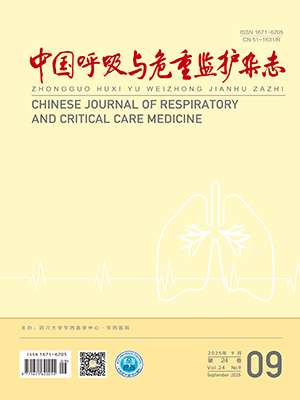| 1. |
Mathers CD, Loncar D. Projections of global mortality and burden of disease from 2002 to 2030. PLoS Med, 2006, 3(11): e442.
|
| 2. |
Polosukhin VV, Richmond BW, Du RH, et al. Secretory IgA deficiency in individual small airways is associated with persistent inflammation and remodeling. Am J Respir Crit Care Med, 2017, 195(8): 1010-1021.
|
| 3. |
Barnes PJ. Cellular and molecular mechanisms of chronic obstructive pulmonary disease. Clin Chest Med, 2014, 35(1): 71-86.
|
| 4. |
Zhao H, Li R, Lv Y, et al. Albuterol inhalation increases FeNO level in steroid-naive asthmatics but not COPD patients with reversibility. Clin Respir J, 2017, 11(3): 328-336.
|
| 5. |
王吉耀, 主编. 内科学. 第 2 版. 北京: 人民卫生出版社, 2010, 41.
|
| 6. |
Han MK, Agusti A, Calverley PM, et al. Chronic obstructive pulmonary disease phenotypes: the future of COPD. Am J Respir Crit Care Med, 2010, 182(5): 598-604.
|
| 7. |
Gastaldi AC, Paredi P, Talwar A, et al. Oscillating positive expiratory pressure on respiratory resistance in chronic obstructive pulmonary disease with a small amount of secretion: a randomized clinical trial. Medicine (Baltimore), 2015, 94(42): e1845.
|
| 8. |
Malerba M, Radaeli A, Olivini A, et al. Exhaled nitric oxide as a biomarker in COPD and related comorbidities. Biomed Res Int, 2014, 2014: 271918.
|
| 9. |
Negewo NA, McDonald VM, Baines KJ, et al. Peripheral blood eosinophils: a surrogate marker for airway eosinophilia in stable COPD. Int J Chron Obstruct Pulmon Dis, 2016, 11: 1494-1504.
|
| 10. |
Feng JX, Lin Y, Lin J, et al. Relationship between fractional exhaled nitric oxide level and efficacy of inhaled corticosteroid in asthma-COPD overlap syndrome patients with different disease severity. J Korean Med Sci, 2017, 32(3): 439-447.
|
| 11. |
Vestbo J, Hurd SS, Agustí AG, et al. Global strategy for the diagnosis, management, and prevention of chronic obstructive pulmonary disease: GOLD executive summary. Am J Respir Crit Care Med, 2013, 187(4): 347-365.
|
| 12. |
王述红. 慢性阻塞性肺疾病患者高分辨率 CT 表型的评价及临床研究[D]. 昆明医科大学, 2014.
|
| 13. |
Hurst JR, Vestbo J, Anzueto A, et a1. Susceptibility to exacerbation in chronic obstructive pulmonary disease. N Engl J Med, 2010, 363: 1128-1138.
|
| 14. |
Dweik RA, Boggs PB, Erzurum SC, et al. An official ATS clinical practice guideline: interpretation of exhaled nitric oxide levels (FENO) for clinical applications. Am J Respir Crit Care Med, 2011, 184(5): 602-615.
|
| 15. |
杨妍, 陈如华, 王岑, 等. 呼出气一氧化氮水平与 COPD 患者血清 IL-6、IL-8、TNF-α 及呼吸功能的相关性. 热带医学杂志, 2017, 17(1): 78-80, 84.
|
| 16. |
Huang SY, Chou PC, Wang TY, et al. Exercise-induced changes in exhaled NO differentiates asthma with or without fixed airway obstruction from COPD with dynamic hyperinflation. Medicine (Baltimore), 2016, 95(15): e3400.
|
| 17. |
Vedel-Krogh S, Nielsen SF, Lange P, et al. Blood eosinophils and exacerbations in chronic obstructive pulmonary disease. The Copenhagen General Population Study. Am J Respir Crit Care Med, 2016, 1932(9): 965-974.
|
| 18. |
Malinovschi A, Ludviksdottir D, Tufvesson E, et al. Application of nitric oxide measurements in clinical conditions beyond asthma. Eur Clin Respir J, 2015, 2: 28517.
|
| 19. |
金晓晴, 陈波, 王颖, 等. 外周血嗜酸粒细胞对重症慢阻肺急性加重期患者疗效及预后评价的研究. 武汉大学学报 (医学版), 2017, 38(3): 475-478.
|
| 20. |
Barnes NC, Sharma R, Lettis S, et al. Blood eosinophils as a marker of response to inhaled corticosteroids in COPD. Eur Respir J, 2016, 47(5): 1374-1382.
|
| 21. |
费凡, 吴桢珍, 朱曼旎, 等. 血嗜酸性粒细胞在慢性阻塞性肺疾病急性加重中的临床意义. 中国呼吸与危重监护杂志, 2019, 18(5): 418-422.
|




